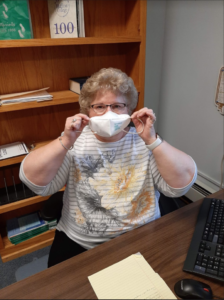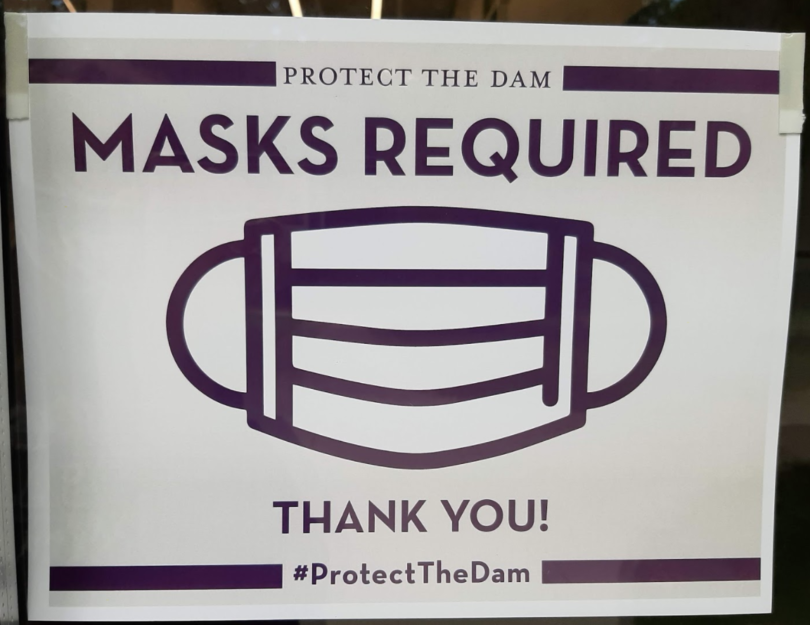Bluffton University students have eagerly moved back onto campus and with that being said, Bluffton’s campus has set into place a requirement for masks to be worn in buildings, classrooms and groups unless they are outside social distancing, if the student is in their residential dorm room or eating.
How are masks useful? Cloth or medical face masks have become a highly recommended way of going day to day through this pandemic. According to the Center for Disease Control, masks act as a barrier to help prevent respiratory droplets from traveling into the air when someone wearing a face mask talks, sneezes or coughs.

Sherri Winegardner, Project Manager for the Student Health and COVID-19 Steering Committee at Bluffton University demonstrates the proper way to hold your mask when you are putting it on or removing it. Photo by Sarah Heydinger.
Sherri Winegardner, director of nursing and project manager for the Student Health and COVID-19 Steering Committee on Bluffton University’s campus, said, “COVID-19 is spread through respiratory droplets, the masks are not to protect ourselves but protect others from ourselves.”
Who should be wearing masks? The CDC suggests that the general population ages 2 and older should wear a mask in a public setting where social distancing cannot be maintained.
“Cloth masks are recommended for the general population, while medical masks are for workers in the medical field,” Winegardner said.
Mask tips
Wearing masks on Bluffton’s campus has become the new normal, but students may still be unsure or unaware of the information they might need to know.
According to an article, “12 Mask Hygiene Tips from Hospital Workers,” you should wear a clean mask every day. If it is a cloth mask it should be washed daily in warm to hot water in any detergent, if it is a medical mask it can be reused as long as it is not visibly dirty, wet or torn.
Some other tips are storing your mask in a paper bag when it is not being used and do not use disinfectant spray to try to clean a mask.
A common mistake most people make is touching their faces or the outside of their face mask throughout the day. Winegardner said on average, a person will touch their face 16 times an hour without even thinking about it.
“Think of the outside of your mask as contaminated and dirty,” Winegardner said. “Every time you put on or remove your mask you should sanitize your hands.”
Winegardner suggests everyone carry a bottle of sanitizer just for that reason.
Another piece of information to think about is the proper way to put on your mask.
“The only part of your mask that you should touch is the straps to fit around your ears and it should also be removed by touching only the straps,” Winegardner said, “Once it is removed, the mouth part should be folded so that the area directly touching your mouth is folded in on each other.”
Winegardner said when a mask is removed, it can be stored best in a paper bag to be able to dry or also in a plastic bag left open to dry.
To sum it up, Winegardner suggests everyone to have a mask that fits snug because it will help to not touch it and will also keep respiratory droplets from escaping out of the loose areas.
“Ear savers” can be used to help lose masks fit better along with avoiding masks hurting your ears. They are simply a piece of plastic that you can wear on the back of your head to hook the mask ear loops to. She said there will be free “ear savers” at the Marbeck desk for those who are interested.







